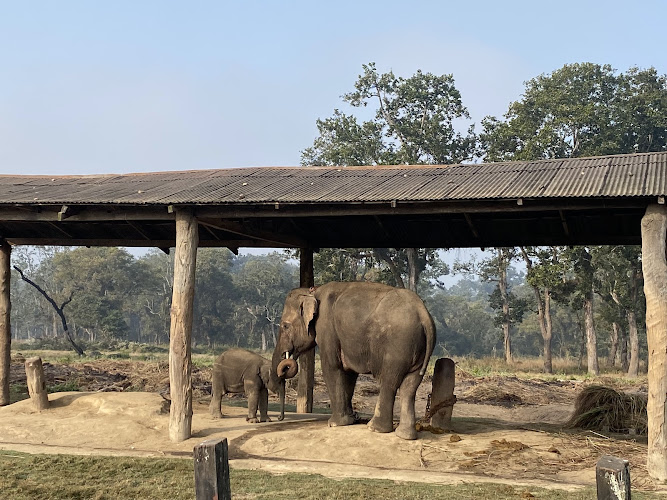

ELEPHANT BREEDING CENTER - Domesticated Elephant Care & Conservation Program
Baadreni Road Royal Chitwan NP., Bharatpur 44204
In Khorsor, Sauraha, just outside Chitwan National Park's boundaries, the National Trust for Nature Conservation operates the Elephant Breeding Center where dozens of domesticated elephants live, breed, and raise calves that will eventually join anti-poaching patrols, tourism safaris, or conservation work across Nepal's protected areas. Established in 1985 when wild elephant capture faced increasing ethical scrutiny and declining wild populations made sustainable harvesting impossible, the breeding center attempts solving a fundamental challenge: how to maintain working elephant populations—essential for jungle patrols and tourism—without depleting wild herds or relying on elephant imports from India or Myanmar.
The center houses breeding females, bulls, and calves in semi-natural conditions with morning foraging in nearby forests, afternoon rest, and evening feedings supplementing wild browse. Visitors arriving mid-morning encounter elephants bathing in the Rapti River, their mahouts scrubbing massive flanks while calves play in shallows under watchful maternal eyes. The juxtaposition strikes observers—wild-appearing elephants engaging in natural behaviors while serving fundamentally domestic purposes controlled by human handlers managing every aspect of their lives from breeding to diet to daily schedules.
Breeding success varies annually but generally produces several calves that visitors can observe nursing, learning to use trunks, and developing social skills under herd guidance. The calves represent both conservation achievement—sustaining captive populations without wild capture—and ethical complexity, as these elephants will never experience true wildness despite living near one of Asia's premier elephant habitats. Critics question whether breeding captive elephants for work purposes qualifies as conservation or simply perpetuates exploitation, while supporters argue that well-cared-for working elephants support conservation by enabling patrols, tourism, and community engagement impossible without elephants' unique capabilities.
The center's educational role extends beyond tourism. Visiting students learn elephant biology, ecology, and conservation challenges including habitat loss, human-elephant conflict, and the ethical debates surrounding captive elephant management. Mahout training programs teach proper elephant care, reducing abuse common in operations prioritizing tourism revenues over animal welfare. Research on elephant reproduction, nutrition, and behavior informs management decisions and contributes to global captive elephant knowledge.
Yet contradictions remain inescapable. Elephants evolved for ranging across hundreds of square kilometers, complex social structures spanning generations, and ecological roles as forest engineers whose feeding and movement patterns shape vegetation communities. The breeding center's elephants experience truncated versions of these evolutionary imperatives—restricted ranges, limited social complexity, and purposes serving human needs rather than ecological functions. Whether this trade-off justifies the outcome depends on valuation frameworks and philosophical stances on animal welfare, conservation, and utility that permit no easy answers.
The breeding center ultimately reflects Nepal's pragmatic conservation approach, accepting imperfect solutions when ideal ones remain unattainable. Wild elephant populations face habitat loss and human-wildlife conflict that may ultimately prove unsurvivable regardless of protection efforts. Maintaining healthy captive populations preserves genetic diversity and elephant-related knowledge if wild populations crash. Working elephants support protected area management and generate tourism revenue funding broader conservation. And carefully managed breeding reduces capture pressures on wild herds. These justifications satisfy some while leaving others convinced that elephants belong only in wilderness, free from human control regardless of consequences.
For visitors to Chitwan, the breeding center offers accessible elephant encounters requiring just a short walk from Sauraha's hotels. The 150-rupee entrance fee supports operations while granting access to watch bathing elephants, observe calves, and learn elephant biology from informational displays. Whether this experience constitutes conservation education or wildlife exploitation depends less on observable facts than on visitor values and interpretive frameworks. The elephants themselves seem indifferent to these debates, consuming fodder, following mahout commands, and occasionally stealing sugarcane from fields, their lives shaped by captivity's constraints and security, forever suspended between wildness and domestication in a conservation strategy that accepts compromise as the price of elephants' continued presence in Nepal's rapidly changing landscapes.
Park Features & Amenities
🛠️ Service options
- ✓ On-site services
Visitor Information
🕐 Best Times to Visit
Spring (Mar-May): Pleasant weather, blooming flowers
Autumn (Sep-Nov): Clear skies, comfortable temperatures
Early Morning: Best for wildlife viewing and photography
🗺️ Getting There
By Car: Baadreni Road Royal Chitwan NP., Bharatpur 44204
Public Transport: Local buses and taxis available
Walking: Check distance from city center
💡 Visitor Tips
• Bring water and sun protection
• Wear comfortable walking shoes
• Check weather conditions before visiting
• Bring camera for nature photography
Explore More in Nepal
Nearby Attractions
Popular Activities
Ready to Visit ELEPHANT BREEDING CENTER?
Plan your visit to this amazing destination with our comprehensive travel guide and insider tips.
Seasonal Travel Guide
Weather & Best Time
Winter brings cool temperatures (5-15°C) with clear skies and snow-capped peaks. Perfect for mountain views but cold at higher altitudes.
Best Activities:
- Mountain viewing
- Cultural experiences
- Spa and hot springs
- Photography of snow peaks
- Indoor cultural activities
Travel Tips
- Visit during December-February for snow-capped views
- Pack warm clothing for cold temperatures
- Book hotels with heating facilities
- Plan for shorter daylight hours
Packing Suggestions:
- Warm winter clothing
- Thermal layers
- Warm hat and gloves
- Sturdy winter boots
- Hot water bottle
Quick Facts
Best time: Autumn (Sep-Nov)
Duration: 1-3 days
Difficulty: Easy
Cost: Budget-friendly